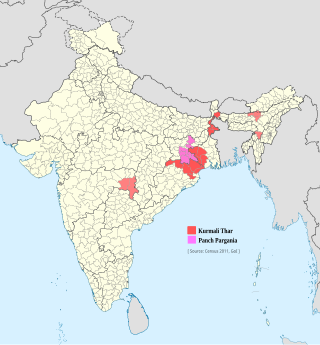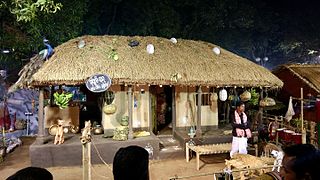Related Research Articles

The Kurukh or Oraon, also spelt Uraon, or Dhangar are a Dravidian speaking ethnolinguistic group inhabiting Chhotanagpur Plateau and adjoining areas - mainly the Indian states of Jharkhand, West Bengal, Odisha and Chhattisgarh. They predominantly speak Kurukh as their native language, which belongs to the Dravidian language family. In Maharashtra, Oraon people are also known as Dhangad or Dhangar.

Bagata people are one of the tribal ethnic groups of India, mainly concentrated in Andhrapradesh and Odisha. As per the Indian constitution, they are designated as Scheduled Tribe for affirmative action.

Bhunjias, are an ethnic group found in India mainly reside in Sunabeda plateau in Odisha and Chhattisgarh. They are mostly found in Nuapada district, which is roughly between 22° 55′ N and 21° 30′ N latitude and 82° 35′ E longitude. It was a part of Khariar Zamindari, which formed the eastern and the southeastern region of Raipur district of Chhattisgarh division in Central Province till 1 April 1936, when it was transferred to Odisha on its creation. It is now in Komna block of Nuapada district in Orissa. In Chhattisgarh they are found in Raipur district.
Chik Baraik is a community found in Indian State of Jharkhand, Chhattisgarh, Odisha. They were traditionally Weaver.

Bhumij is a Munda ethnic group of India. They primarily live in the Indian states of West Bengal, Odisha, and Jharkhand, mostly in the old Singhbhum district. Also in states like Bihar and Assam. There is also a sizeable population found in Bangladesh. Bhumijas speak the Bhumij language, an Austroasiatic language, and use Ol Onal script for writing.

Kurmali or Kudmali is an Indo-Aryan language classified as belonging to the Bihari group of languages spoken in eastern India. As a trade dialect, it is also known as Panchpargania, for the "five parganas" of the region it covers in Jharkhand. Kurmali language is spoken by around 5.5 lakh people mainly in fringe regions of Jharkhand, Odisha and West Bengal, also a sizable population speak Kurmali in Assam tea valleys. Intellectuals claim that Kurmali may be the nearest form of language used in Charyapada. Kurmali is one of the demanded languages for enlisting in Eighth Schedule to the Constitution of India.
The Banaut is a branch of the Rajput found in the Indian states of Bihar and Jharkhand. The Banaut speak Angika and Maithili.

Chuar rebellion, also known as Jungle Mahal movement was a series of peasant movements between 1766 to 1816 by the tribal inhabitants of the countryside surrounding the Jungle Mahals settlements of Midnapore, Bankura and Manbhum against the rule of the East India Company (EIC). This was the first revolt against the East India Company (EIC) in Chotanagpur areas of Bengal Presidency.
Gandhabanik is a Bengali Hindu trading caste, who as the caste name suggests, traditionally used to trade in perfumes, cosmetics, spices etc. They were also engaged in agriculture. As of late nineteenth century they were one of the fourteen castes belonging to Nabasakh group. There is almost one hundred percent literacy among the present gandhabanik generation.
Gopa or Gop or Gope is a synonym of the Yadav (Ahir) caste. It is generally used as a title by the Ahir caste in the states of Bihar, Jharkhand and West Bengal of East India and even in Terai region of Nepal.

The Bathudi are a community found mainly in the north western part of Odisha. Some Bathudis, however migrated to neighbouring states of Jharkhand and West Bengal. The 2011 census showed their population to be around 220,859. They are classified as a Scheduled Tribe by the Indian government.
The Kora are an ethnic group found in the Indian states of West Bengal, Odisha and Jharkhand and the Bangladeshi division of Rajshahi. The 2011 census showed their population to be around 260,000. They are classified as a Scheduled Tribe by the Indian government.
The Barik or Barika or Bhandari is an Indian caste found from Odisha State in India. Traditionally they are barbers by profession. Their service is indispensable on the occasion of marriage, birth and death. They are also required for carrying luggage bags of bride and groom in Hindu weddings.
Krishnaut or Krishnaut Ahir or Krishnaut Yaduvanshi is a clan of the Hindu Ahir (Yadav) caste found in Bihar, Jharkhand, and parts of the Indian state of Uttar Pradesh. The term Krishnaut denotes their claimed descent from Lord Krishna.

Bagal is a cattle herding caste of East India. Bagal people are living in the state of West Bengal, Jharkhand and Odisha. They use Kudmali / Manbhumi dialect of Bengali as mother tongue and use Bengali, Hindi and Odia language to communicate with the society.
Rajuar is a shifting cultivation community. The people of this community mainly live in Bihar, Jharkhand, Madhya Pradesh, Odisha and West Bengal. The community living in Odisha is considered a Scheduled Tribe while the people living in other states are considered as OBC.
Gour or Goud or Gound is a caste of Jharkhand, Odisha and West Bengal. Locally they are also known as Ahir, Goud Gowala, Gour Gowala. Most of them speak the local form of Bengali language which they lebel as Gourali language and other multilingually speak Ho, Mundari, Kurmali language.
The Karmali is an artisan tribe of Jharkhand. It is composed of blacksmiths. They are mainly concentrated in Ramgarh, Bokaro, Hazaribagh, Giridih and Ranchi district of Jharkhand and sizable population also found in West Bengal and Assam. They speak Khotta language in their home and Hindi language with society. As per 1981 census their population in the state was 38,651. They are considered as Scheduled Tribe in West Bengal and Jharkhand.
The Majhraut or Majraut is a clan of Hindu Ahir (Yadav) caste that inhabits the Indian state of Bihar and Jharkhand.
Puran is caste group of East India. They are considered as OBC and they are primarily inhabitants of Odisha, West Bengal and Jharkhand.
References
- 1 2 3 4 "Census of India Website : Office of the Registrar General & Census Commissioner, India". www.censusindia.gov.in. Government of India. Archived from the original on 7 September 2015. Retrieved 23 October 2017.
- 1 2 "Binjhia". Home. Retrieved 2020-07-08.
- ↑ Mhaiske, V.M.; Patil, V.K.; Narkhede, S.S. (2016). Forest Tribology And Anthropology. Scientific Publisher. p. 168. ISBN 978-93-86102-08-9 . Retrieved 2020-06-23.
- ↑ Das, N.K. (2012). Odisha. Odisha. Seagull Books. p. 396. ISBN 978-81-7046-293-4 . Retrieved 2020-07-08.
- ↑ Minz, D.; Hansda, D.M. (2010). Encyclopaedia of Scheduled Tribes in Jharkhand. Kalpaz Publications. p. 47. ISBN 978-81-7835-121-6 . Retrieved 2020-07-08.
- ↑ Singh, K.S.; Anthropological Survey of India (1998). India's Communities. People of India. Oxford University Press. p. 497. ISBN 978-0-19-563354-2 . Retrieved 2020-07-08.
- ↑ Singh, K.S.; Anthropological Survey of India (2008). People of India. People of India. Anthropological Survey of India. p. 187. ISBN 978-81-7046-302-3 . Retrieved 2020-07-08.
- 1 2 Singh, K.S.; Anthropological Survey of India (1998). India's Communities. People of India. Oxford University Press. p. 498. ISBN 978-0-19-563354-2 . Retrieved 2020-07-08.
- ↑ Minz, D.; Hansda, D.M. (2010). Encyclopaedia of Scheduled Tribes in Jharkhand. Kalpaz Publications. p. 48. ISBN 978-81-7835-121-6 . Retrieved 2020-07-08.